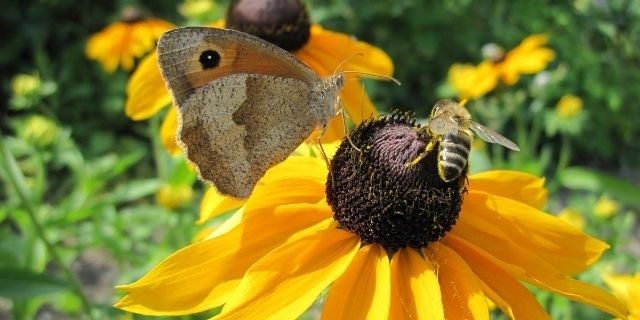27
Oct
Global Pollinator Declines Threaten Plant Biodiversity

(Beyond Pesticides, October 27, 2021) Declines in pollinator populations throughout the world may result in the loss of tens of thousands of wild flowering plants that rely on their services, according to research published this month in the journal Science Advances. “Our paper provides the first global estimate of how many plant species mostly or completely rely on animal pollinators to make seeds and thus to reproduce,” wrote author James Rodger, PhD, in an article in The Conversation. “We found that it’s about 175,000 plant species – half of all flowering plants. This means declines in pollinators could cause major disruptions in natural ecosystems, including loss of biodiversity.”
Pollinators are being threatened with multiple interacting stressors, from climate change, to pesticide use, disease, habitat destruction, and other factors. In the US, an increasing number of pollinators, including iconic species like the American bumblebee and monarch butterfly, are being added or in consideration for listing under the Endangered Species Act. Systemic neonicotinoid insecticides implicated for their earth-spanning hazards to pollinator populations themselves put 89% or more of U.S. endangered species at risk.
Many are aware of the fact that pollinators help make available one in three bites of food. Research studies show that pollinators are part of a complex ecosystem that contributes to farm productivity, income, and environmental protection, and their protection provides greater benefits across the board than pesticide use. But the effect of pollinator losses could stretch even further – with cascading impacts that could harm entire ecosystems. To determine how needed pollinators are for plant reproduction worldwide, the authors of the current study amassed a dataset of prior pollen research containing over 1,174 plant species, providing a globally representative analysis of pollinator contributions to flowering plants.
After working through variables relating to pollinator dependency, including self-fertilized, and pollen limited plants that improve seed production when pollinators were present, researchers were able to characterize what would happen in the absence of pollinators. Accordingly, without pollinators half of plant species would experience a reduction in fertility by over 80%, and one third of flowering plant species with no longer produce seeds at all.
Tree species appear to be at greatest risk, as well as plants reliant on highly specialized pollinators, those requiring multiple visits by pollinators, and plants in tropical regions. In the face of declining pollinators, some plants will be able to adapt new strategies. “Even through some plants might evolve to be more auto-fertile on the one hand, or more attractive to the remaining pollinators on the other hand, this will not be possible for all plant species,” Dr. Rodger writes. “Some plants will be at risk of extinction.”
This trend could become a positive feedback spiral for pollinator populations. As plants die-off or adapt to fewer pollinators, pollinators play less of a role, finding less food and resulting in further stress. But the study does provide some hopeful signs if pollinator declines are addressed quickly. “Most plants are quite long-lived, so it will take some years for these plant populations to start to decline and go extinct, even if pollinator declines reduce their reproduction,” Dr. Rodger notes. He further suggests work to avoid pesticide use harming pollinators, and to conserve their remaining habitat.
Concerned residents and pollinator advocates are encouraged to take these steps not only in and around their properties, but at their place of work, and in their community in local parks and natural areas. For Pollinator Week 2021 Beyond Pesticides suggested actions to create pollinator habitat, go organic with your community, and urge comprehensive action at the federal level to protect declining populations. With the crisis continuing, we must redouble these efforts. Commit to taking meaningful action to protect pollinators, the plants, people, and entire ecosystems that rely upon them.
All unattributed positions and opinions in this piece are those of Beyond Pesticides
Source: The Conversation, Science Advances










